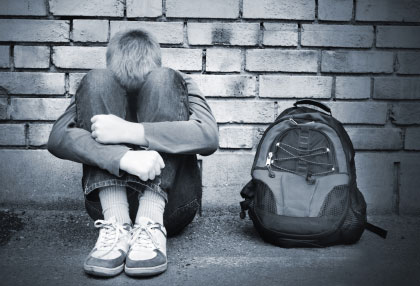Teaching Resilience: A New Approach to Bullying
- Details
- Published on March 01, 2013
Though some people dismiss bullying with the age-old adage “kids will be kids,” the issue of bullying in schools has become a serious public health issue. According to the National Education Association (NEA), one in seven students between grades K-12 are either a bully or a victim of bullying. There are many different types and degrees of bullying, but the psychological and emotional effects are usually the same: victims feel depressed, angry, isolated, and fearful. The NEA also states that approximately 160,000 children miss school every day because they fear attack or intimidation by other students.

As bullying increases and becomes more severe, young people resort to extreme measures to deal with their emotions. Without being taught positive coping mechanisms, such as seeking adult and peer support, victims are vulnerable to self-harm tactics, such as cutting and suicide. According to data collected by the Center for Disease Control and Prevention (CDC) between the years 2005-2009, suicide is the third leading cause of death among young people ages 10-24, resulting in about 4,400 deaths per year. Bullying victims are up to nine times more likely to commit suicide.
In addition, some victims feel so angry at being bullied that they desire to get revenge on their transgressors by lashing out in violent ways, such as fighting and using weapons. The American Psychological Association (APA) stated that in a study, conducted by the Secret Service and the U.S. Department of Education of 37 school shootings, results showed that two thirds of school shooters had felt bullied, harassed, threatened or injured by others. Although not every bullied child turns to violence, the effects of bullying remain a serious issue.
The National Bullying Prevention Center is an online resource for young people who are victims of bullying. In one section of their website, people can post their personal testimonies, songs, videos, or poems. A fortunate few who have managed to escape their bullying situations post messages of encouragement and support. But the postings of many victims reveal that they are desperate for hope or, sadly, have given up. Consider the following excerpt from a poem titled “Is Your Joke Still Funny?” by an anonymous post:
- Is your joke still funny
- When im breaking piece by piece?
- Do you feel better now
- When the pain is my release?
- Does it make you smile
- When im always terrified?
- Is your joke still funny
- When im sick of all your lies?
- Is your joke still funny
- When im face to face with death?
- Do you feel better now
- When i have nothing left?
- Does it make you smile
- When i dont want to wake up?
- Is your joke still funny
- When they leave me with the cuts?
This victim talks of pain, cutting, and facing death. Feelings of constant terror and of having nothing left led this young poet to not want to live anymore. Similar sentiment can be found on practically every page of the website. This poses an important question for advocates and researchers: why do some people overcome bullying, while others suffer from despair? After scrolling through pages and pages of personal testimony, one common theme emerges: victims of bullying resort to self-harm and suicidal thoughts because they feel their situation will never change.
To test this theory, Stanford University doctoral student David Yeager conducted a study measuring the effects of bullying after teaching resilience to teenagers. He states that “those who are resilient believe that being bullied doesn’t last forever because they know that people have the capacity for change.” In a series of controlled experiments, he developed and staged novel interventions in high schools to reduce behavioral aggression and promote resilience over time. Classrooms teachers explained to students the science behind people’s potential for change, and then students were taught extensive coping skills. After conducting experiments where certain students were excluded from activities with others and then offered the chance to retaliate, those who were taught resilience were three times more likely to respond positively to their bullies. At the end of the study, Yeager found that this approach also reduced school absences, suspensions for fighting, and depression among victimized students.
Yeager’s research gives an insightful new approach to reducing the effects of bullying and has implications for future behavior interventions at schools, which merit further investigation. His message is clear â by teaching resilience, the threat of permanence is mitigated. Without this threat, teenagers are less likely to resort to drastic coping measures and more likely to confront bullies in a confident, positive way.



 A total of 8,059 students 18-25 years
of age from 23 Indiana colleges participated in the Indiana College Substance Use Survey conducted in Spring 2021.
A total of 8,059 students 18-25 years
of age from 23 Indiana colleges participated in the Indiana College Substance Use Survey conducted in Spring 2021.








